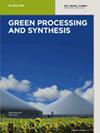利用反硝化-分解模型估算越南红河三角洲水稻和一年生高地作物的温室气体排放量
IF 3.8
4区 工程技术
Q2 CHEMISTRY, MULTIDISCIPLINARY
引用次数: 0
摘要
本研究利用反硝化-分解(DNDC)模型和 ArcGIS 10.1 计算并量化了越南红河三角洲水稻和一年生高地作物的温室气体(GHG)潜力。在实验地点对温室气体排放量进行了监测、分析和计算。对用于温室气体排放计算的 DNDC 模型的运行机制、参数敏感性分析、校准和验证进行了研究,并建立了一套参数。结果表明,实际值与模拟值之间具有良好的相关性。根据红河三角洲及其周边地区的气象站数据集、土地利用现状图、地形图和土壤图,建立了气象-土壤-土地利用复合图。该地图的每个单元都包含完整的气候、土壤和农作物信息,作为农作物生产温室气体排放建模的输入数据。根据空间分析和收集的输入数据,利用 DNDC 模型测量和计算了红河三角洲耕地(一年生水稻和高地作物)的温室气体排放量。该模型的输出结果被用于绘制气候、土壤和作物复合图中每个单元的全球升温潜能值(CH4、N2O)分布专题图。本文章由计算机程序翻译,如有差异,请以英文原文为准。
Estimation of greenhouse gas emissions from rice and annual upland crops in Red River Delta of Vietnam using the denitrification–decomposition model
This study used the denitrification–decomposition (DNDC) model and ArcGIS 10.1 to calculate and quantify the greenhouse gas (GHG) potential from rice and annual upland crops in the Red River Delta of Vietnam. GHG emissions were monitored, analyzed, and calculated at experimental sites. The operating mechanism, sensitivity analysis of the parameters, calibration, and verification of the DNDC model for the GHG emission calculation were studied and performed, and a set of parameters was built. A good correlation between actual and simulated values was shown. From the data set of meteorological stations in and around the Red River Delta, the current land-use map, the topographic and soil map, a complex map of meteorology–soil–land use was built. Each unit of this map contains complete information about climate, soil, and crops as input data for modeling GHG emissions from crop production. From the spatial analysis and collected input data, GHG emissions were measured and calculated for the cultivated field of the Red River Delta (annual rice and upland crops) using the DNDC model. The model's outputs were used to build thematic maps on the distribution of global warming potential (CH4, N2O) for each unit of the complex map of climate, soil, and crops.
求助全文
通过发布文献求助,成功后即可免费获取论文全文。
去求助
来源期刊

Green Processing and Synthesis
CHEMISTRY, MULTIDISCIPLINARY-ENGINEERING, CHEMICAL
CiteScore
6.70
自引率
9.30%
发文量
78
审稿时长
7 weeks
期刊介绍:
Green Processing and Synthesis is a bimonthly, peer-reviewed journal that provides up-to-date research both on fundamental as well as applied aspects of innovative green process development and chemical synthesis, giving an appropriate share to industrial views. The contributions are cutting edge, high-impact, authoritative, and provide both pros and cons of potential technologies. Green Processing and Synthesis provides a platform for scientists and engineers, especially chemists and chemical engineers, but is also open for interdisciplinary research from other areas such as physics, materials science, or catalysis.
 求助内容:
求助内容: 应助结果提醒方式:
应助结果提醒方式:


